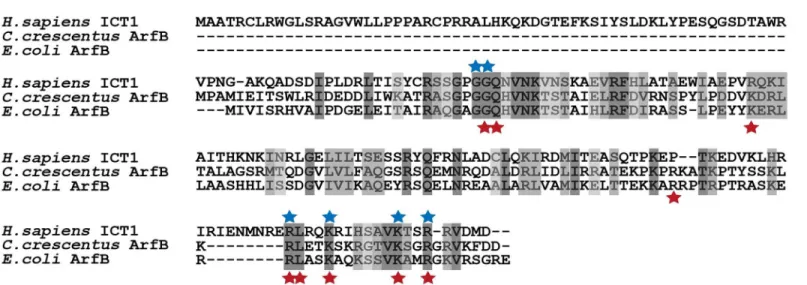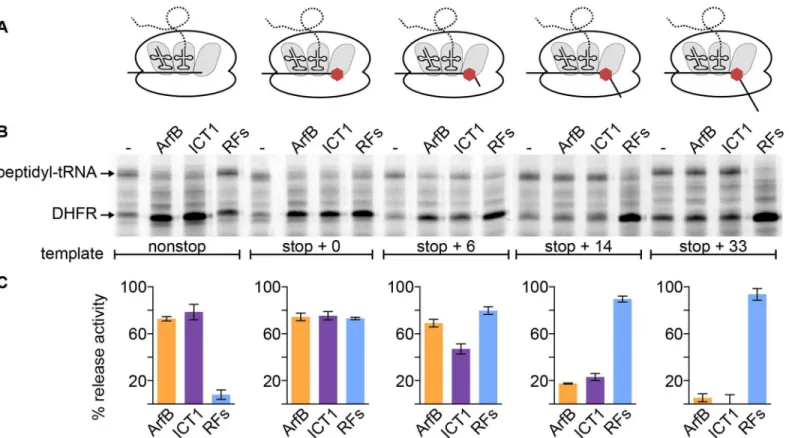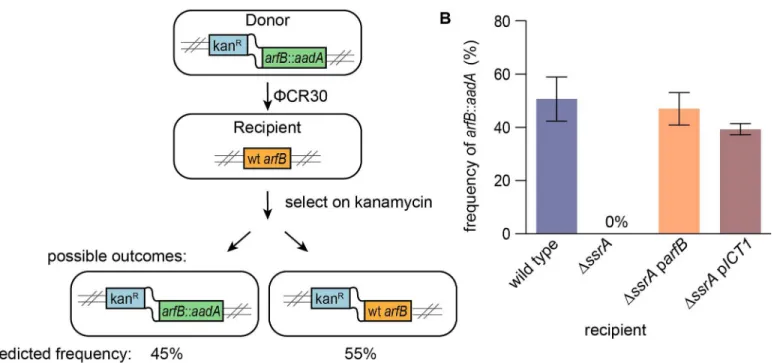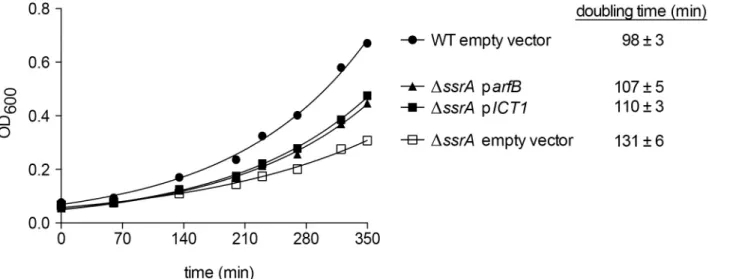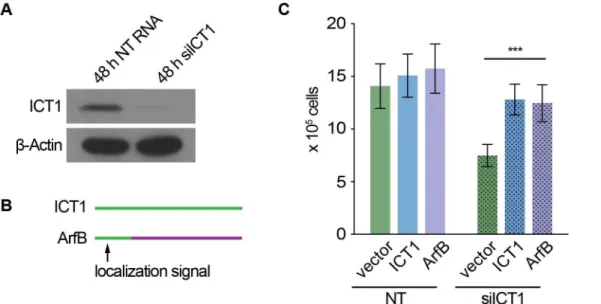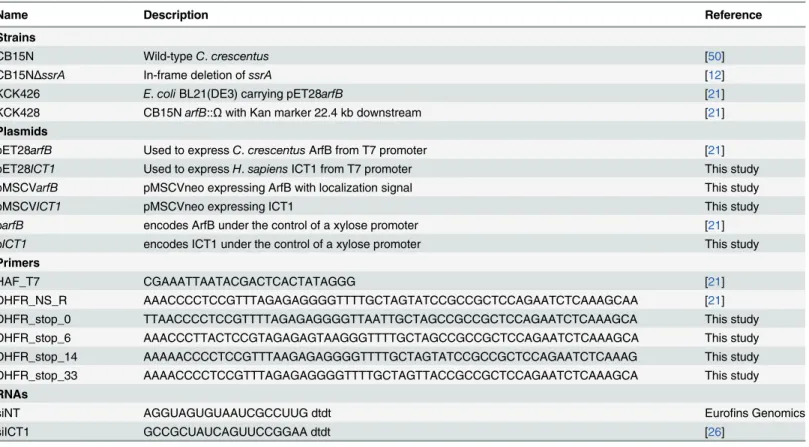RESEARCH ARTICLE
Human Cells Require Non-stop Ribosome
Rescue Activity in Mitochondria
Heather A. Feaga1, Michael D. Quickel2, Pamela A. Hankey-Giblin2, Kenneth C. Keiler1*
1Department of Biochemistry and Molecular Biology, The Pennsylvania State University, University Park, Pennsylvania, United States of America,2Department of Veterinary and Biomedical Science, The Pennsylvania State University, University Park, Pennsylvania, United States of America
*kck11@psu.edu
Abstract
Bacteria usetrans-translation and the alternative rescue factors ArfA (P36675) and ArfB (Q9A8Y3) to hydrolyze peptidyl-tRNA on ribosomes that stall near the 3' end of an mRNA during protein synthesis. The eukaryotic protein ICT1 (Q14197) is homologous to ArfB. In vitro ribosome rescue assays of human ICT1 andCaulobacter crescentusArfB showed that these proteins have the same activity and substrate specificity. Both ArfB and ICT1 hydro-lyze peptidyl-tRNA on nonstop ribosomes or ribosomes stalled with6 nucleotides extend-ing past the A site, but are unable to hydrolyze peptidyl-tRNA when the mRNA extends14 nucleotides past the A site. ICT1 provided sufficient ribosome rescue activity to support via-bility inC.crescentuscells that lacked bothtrans-translation and ArfB. Likewise, expression of ArfB protected human cells from death when ICT1 was silenced with siRNA. These data indicate that ArfB and ICT1 are functionally interchangeable, and demonstrate that ICT1 is a ribosome rescue factor. Because ICT1 is essential in human cells, these results suggest that ribosome rescue activity in mitochondria is required in humans.
Author Summary
Ribosomes can stall during protein synthesis on truncated or damaged mRNAs that lack a stop codon. In bacteria, these“non-stop”ribosomes are rescued bytrans-translation or by an alternative rescue factor, ArfA or ArfB. Most eukaryotes do not havetrans-translation, but mammals have a homolog of ArfB named ICT1. ICT1 is targeted to mitochondria, and is essential in human cells. Here, we show that human ICT1 and ArfB from the bacte-riumCaulobacter crescentushave the same biochemical activity and specificity. We also demonstrate that ICT1 and ArfB are functionally interchangeable in both bacteria and human cells. Collectively, this work demonstrates a new essential function in human cells—rescue of mitochondrial non-stop translation complexes.
Introduction
The presence of a stop codon at the end of an open reading frame signals that the nascent pro-tein is complete. Decoding of the stop codon by a release factor results in peptidyl-tRNA a11111
OPEN ACCESS
Citation:Feaga HA, Quickel MD, Hankey-Giblin PA, Keiler KC (2016) Human Cells Require Non-stop Ribosome Rescue Activity in Mitochondria. PLoS Genet 12(3): e1005964. doi:10.1371/journal. pgen.1005964
Editor:Christopher S Hayes, University of California Santa Barbara, UNITED STATES
Received:January 20, 2016
Accepted:March 7, 2016
Published:March 30, 2016
Copyright:© 2016 Feaga et al. This is an open access article distributed under the terms of the Creative Commons Attribution License, which permits unrestricted use, distribution, and reproduction in any medium, provided the original author and source are credited.
Data Availability Statement:All relevant data are within the paper and its Supporting Information files.
Funding:This work was supported by grant GM068720 from the National Institute of General Medical Sciences to KCK. The funders had no role in study design, data collection and analysis, decision to publish, or preparation of the manuscript.
hydrolysis, releasing the completed protein and allowing the ribosome to be recycled [1]. Spe-cific contacts between the release factors and bases in the stop codon are required for efficient catalysis of peptidyl-tRNA hydrolysis [2]. This stop codon recognition is necessary to prevent release factors from acting at sense codons and prematurely terminating translation. However, ribosomes can sometimes translate to the end of an mRNA without terminating at an in-frame stop codon. Translation cannot terminate normally at these“non-stop”complexes, because there is no stop codon in the decoding center to promote release factor activity. Ribosomes must be rescued from non-stop complexes so they can be recycled for productive protein syn-thesis [3,4].
In bacteria, non-stop complexes are rescued primarily bytrans-translation. Duringtrans -translation, a small protein, SmpB (P0A832), and a specialized RNA, tmRNA (EG30100), rec-ognize a non-stop complex and release the ribosome at a stop codon within tmRNA.trans -Translation also targets the nascent polypeptide and mRNA from the non-stop complex for degradation [3,5]. Genes encoding tmRNA or SmpB have been identified in>99.9% of sequenced bacterial genomes [4].trans-Translation is essential in some bacteria [6–8], but other species can survive withoutssrA(encoding tmRNA) andsmpB[9–11]. Some species, such asC.crescentus, have a severe growth defect whenssrAis deleted [12]. In other species, such asEscherichia coli, there is a relatively mild phenotype [13]. Synthetic-lethal screens have identified two alternative rescue factors, ArfA and ArfB, that can rescue non-stop complexes in the absence oftrans-translation [14–16]. ArfA, found inE.coliand closely related bacteria, allows the release factor RF-2 to hydrolyze peptidyl-tRNA on non-stop ribosomes [17–20]. ArfB, found inC.crescentusand species from many phyla, contains a catalytic domain similar to release factors but does not include domains required for stop codon recognition. ArfB cata-lyzes hydrolysis of peptidyl-tRNA on non-stop ribosomes [15,16,21]. The C-terminal tail of ArfB is important for its activity [22], and structural studies suggest that it binds in the empty mRNA channel of non-stop ribosomes, similar to the C-terminal tail of SmpB [23].arfAis essential inE.coliΔssrAcells [14], andarfBis essential inC.crescentusΔssrAcells [21], indicat-ing that these species require at least one ribosome rescue mechanism. These observations have led to the suggestion that ribosome rescue activity may be essential for most or all bacteria [5].
Eukaryotes use Dom34/Pelota (P33309/Q9BRX2) and Hbs1 (P32769) to rescue ribosomes from non-stop mRNAs during translation in the cytoplasm [24,25], but factors required for this system are not present in mitochondria. Mammals have an ArfB homolog, ICT1, which is encoded in the nucleus and transported to mitochondria [26]. Knockdown experiments have demonstrated that ICT1 is essential in human cells [26,27], but conflicting models have been proposed to explain why ICT1 is essential [28–30]. Like ArfB, ICT1 can hydrolyze peptidyl-tRNA onE.colinon-stop ribosomes in vitro [22]. Because ICT1 can also hydrolyze peptidyl-tRNA onE.coliribosomes assembled on short mRNAs with a stop or sense codon in the A site, it has been proposed to act as a general release factor that can terminate translation at any codon [26]. ICT1 has also been proposed to act on ribosomes stalled in the middle of an mRNA based on its ability to promote protein synthesis in reactions stalled by omission of a cognate release factor or tRNA [31]. Two mRNAs encoded in human mitochondria terminate with an AGA or AGG codon, so if ICT1 can act as non-specific release factor it might termi-nate translation of these messages. However, the sequence similarity between ICT1 and ArfB suggests that these factors are likely to have the same activity. ICT1 and ArfB share the con-served GGQ motif found in release factor catalytic domains, as well as residues in the C-termi-nal tail that are required for ArfB activity on non-stop ribosomes (Fig 1) [22,31]
past the A site, but have little activity on ribosomes stalled in the middle of an intact mRNA. In addition, we find that ArfB and ICT1 are interchangeable in vivo, both inC.crescentusand in human cells. These data indicate that ICT1 is a ribosome rescue factor and cannot terminate translation in the middle of mRNA, and suggest that mitochondrial ribosome rescue activity is essential in humans.
Results
Human ICT1 hydrolyzes peptidyl-tRNA on non-stop translation
complexes
To evaluate the substrate specificity of ICT1, we used a gel-based assay to measure peptidyl-tRNA hydrolysis onE.coliribosomes translating protein from mRNA. In these experiments, protein is produced using in vitro transcription-translation reactions and the components are separated on Bis-Tris gels that preserve the ester bond in peptidyl-tRNA. The fraction of pro-tein that remains in the peptidyl-tRNA band indicates the extent of peptidyl-tRNA hydrolysis during the reaction [21].
To confirm that ICT1 can hydrolyze peptidyl-tRNA on non-stop ribosomes in a manner similar to ArfB, a coupled transcription-translation system lacking RF1, RF2, and RF3 was used to express afolAgene (encoding DHFR) that lacked a stop codon. Consistent with previ-ous observations of peptidyl-tRNA hydrolysis on non-stop ribosomes [15,16,21], addition of a release factor mixture containing RF-1, RF-2, and RF-3 to the reaction had little effect on the percentage of DHFR found in peptidyl-tRNA, but when ArfB was included 74 ± 1% of the DHFR was released (Fig 2). When ICT1 was included in the reaction, 78 ± 8% DHFR was released, indicating that ICT1 has a similar activity to ArfB on non-stop ribosomes.
To determine if ICT1 and ArfB can also release ribosomes stalled with mRNA extending into or past the A site, the peptidyl-tRNA hydrolysis assay was repeated with longerfolA tem-plates. A stop codon was added to the end of the non-stop template, and 0, 6, 14, or 33
Fig 1. ICT1 and ArfB share conserved residues that are required for release activity.Clustal Omega alignment of human ICT1 and ArfB proteins fromE.
COLIandC.CRESCENTUS. Blue stars indicate residues required for60% ICT1 peptidyl-tRNA hydrolysis activity on non-stop ribosomes [22]. Red stars indicate residues required for60%E.COLIArfB hydrolysis activity on non-stop ribosomes [22]. The N-terminal extension of ICT1 contains the
mitochondrial localization signal. The remaining 143 C-terminal residues, thought to constitute the active portion of ICT1, share 26% sequence identity with
C.CRESCENTUSArfB. doi:10.1371/journal.pgen.1005964.g001
nucleotides were added after the stop codon. Each template was designed to produce an mRNA with a stem-loop at the 3’end to limit exonuclease activity during the reaction. Transla-tion of these mRNAs will result in a ribosome stalled at the stop codon with peptidyl-tRNA in the P site. As expected, addition of release factors to reactions with any of these templates resulted in release of most of the peptidyl-tRNA (Fig 2). ICT1 and ArfB hydrolyzed peptidyl-tRNA as efficiently as release factors when the stop + 0 template was used. Substantial pepti-dyl-tRNA hydrolysis activity by ICT and ArfB was also observed with the stop + 6 template, but significantly less activity was observed when the template had a longer sequence past the stop codon (p<0.001). Almost no hydrolysis was observed with ICT1 or ArfB on the stop + 33 template. These results indicate that ICT1 and ArfB can hydrolyze peptidyl-tRNA on ribosomes stalled near the 3’end of an mRNA, and that a codon in the A site does not interfere with ribosome rescue. However, mRNAs that extend14 bases past the A site substantially decrease activity of both ICT1 and ArfB.
Human ICT1 has ArfB activity inC.crescentus. The activity of ICT1 and ArfB in vitro
was similar enough to suggest that ICT1 might substitute for ArfB inC.crescentus. In a previ-ous study, we used genetic linkage analysis to demonstrate that deletions ofssrAandarfBare synthetically lethal inC.crescentus[21]. A phageFCR30 lysate was prepared from strain KCK 428. In this strain,arfBis replaced with a copy of theaadAgene (conferring resistance to spec-tinomycin) and a copy of thenptIIgene (conferring resistance to kanamycin) is inserted in the chromosome 22 kb from thearfBlocus. The co-transduction frequency of the two antibiotic Fig 2. ICT1 and ArfB hydrolyze peptidyl-tRNA on ribosomes near the 3’end of an mRNA.In vitro transcription/translation reactions were performed with template lacking a stop codon, or with template with 0, 6, 14, or 33 bases past the stop codon. (A) Cartoons depicting the expected result of translation in the absence of added rescue or release factors. (B) Representative autoradiograms of reactions resolved on Bis-Tris gels. (C) Column graphs show average release activity from3 replicates with error bars indicating the standard deviation.
resistance markers could then be measured by infecting recipient cells with phage, selecting for transductants on kanamycin, and screening the kanamycin-resistant cells for spectinomycin resistance. Based on their relative locations on the chromosome, the predicted frequency with which theaadAandnptIIgenes should co-transduce whenarfBis not essential is 45% [32]. Consistent with this prediction, when lysate is used to infect wild-type cells,arfB::aadAis recovered at a frequency of 51 ± 8% When this lysate was used to infectΔssrAcells, transduc-tants with thearfBdeletion were not recovered, indicating thatarfBis essential in the absence ofssrA. To determine if ICT1 could provide ribosome rescue activity to support viability ofC. crescentus, the co-transduction experiment was repeated usingΔssrAcells that contained ICT1 (Fig 3). When theΔssrAstrain expressed ICT1 from a plasmid,arfBcould be deleted, as indi-cated by the co-transduction ofarfB::aadAwith thenptIIgene. The co-transduction frequency ofaadAandnptIIintoΔssrAcells expressing ArfB or ICT1 was not significantly different (p = 0.12), indicating that ICT1 can suppress the synthetic-lethal phenotype of deletingarfB andssrA. In contrast, whenΔssrAcells harboring empty plasmid were used as the recipient, none of>500 kanamycin-resistant transductions were resistant to spectinomycin (Fig 3).
ICT1 suppresses the growth defect inC.crescentusΔssrAcells. Previous characterization
oftrans-translation and ArfB activity inC.crescentusshowed that cells lackingtrans -transla-tion grow slowly [12], and over-expression of ArfB partially suppresses this growth defect [21]. To determine if ICT1 can perform the same function as ArfB in this assay, the growth rate of theΔssrAstrain expressing ICT1 was measured and compared to control strains.ΔssrAcells expressing ICT1 cells grew at a rate similar toΔssrAcells expressing ArfB, and significantly faster thanΔssrAcells (p<0.01) (Fig 4). These results indicate that ICT1 activity supports the same rate of growth as ArfB activity, and suggest that human ICT1 is functionally interchange-able with ArfB inC.crescentus.
Fig 3. ICT1 ribosome release activity supports viability inc.crescentus.A co-transduction experiment was used to test whether ICT1 complements the synthetic lethal phenotype of deletingARFBandSSRA. (A) Cartoon depicting the co-transduction experiment and predicted frequency of the outcomes if
ARFBwere not essential. (B) Column graph indicating the average co-transduction frequency from 3 independent experiments, with error bars indicating the standard deviation.
doi:10.1371/journal.pgen.1005964.g003
ArfB rescues human cells when ICT1 is silenced. Mutant versions of ICT1 that lack the GGQ motif required for peptidyl-tRNA hydrolysis do not support viability in human cells when the endogenous ICT1 is silenced [26], indicating that ICT1-mediated peptidyl-tRNA hydrolysis is essential. If the essential activity of ICT1 is rescue of non-stop ribosomes,C. cres-centusArfB might be able to support viability in the absence of ICT1. To test this possibility, a gene encoding the N-terminal sequence of ICT1 containing the mitochondrial localization sig-nal [33] fused to ArfB was constructed. HEK293 cells were transfected with a vector to express ArfB or ICT1, or with an empty vector. Eight hours later, these cells were transfected with siRNA that silenced ICT1 or with control siRNA, and after 6 days the number of living cells was determined. Consistent with previous results, ICT1 silencing decreased the number of via-ble cells, but cells expressing a version of ICT1 that was not silenced by the siRNA were not affected. Expression of ArfB prior to ICT1 silencing also prevented loss of viability. Cells expressing ArfB prior to ICT1 silencing grew to significantly higher numbers than cells trans-fected with vector alone (p<0.0001) (Fig 5). There was no significant difference in viable cell number when cells were rescued with ArfB versus ICT1 (p = 0.75). These results indicate that ArfB can perform the essential function of ICT1 in human cells.
Discussion
Rescue of ribosomes from non-stop translation complexes is a critical function for most bacte-ria, and the results presented here indicate that rescue of mitochondrial ribosomes is also essential in some eukaryotes.C.crescentuscells can survive without tmRNA and SmpB because they have ArfB to rescue ribosomes in the absence oftrans-translation [21]. We have previ-ously shown thatC.crescentusArfB can hydrolyze peptidyl-tRNA from non-stop ribosomes in vitro [21]. The data described here show that ArfB is also active on ribosomes stalled with a full codon in the A site or with 6 nucleotides past the A site, but longer mRNA extensions strongly inhibit ArfB activity. This substrate specificity is similar to that observed for tmRNA-SmpB [34–36], and indicates that ArfB is unlikely to interfere with translation elongation or with ribosomes paused during translation of full-length mRNAs. Instead, ArfB activity is consistent Fig 4. expression of ICT1 partially complements the growth defect ofδssracells.Growth of wild-type cells,ΔSSRAcells, orΔSSRAcells expressing ArfB or ICT1 from a plasmid was monitored during exponential phase. The average doubling times (±standard deviation) from3 experiments are shown.
with a role in rescuing ribosomes that have translated to the 3’end of an mRNA without termi-nating, ribosomes that have stalled after cleavage of the mRNA in the A site by a nuclease such as RelE [37], and stalled ribosomes that have had the 3’portion of the mRNA removed by exo-nuclease activity [36,38].
Several lines of evidence demonstrate that human ICT1 is a ribosome rescue factor like ArfB, and not a non-specific release factor that can act on ribosomes stalled in the middle of an mRNA. First, the specificity of ICT1 in vitro for non-stop ribosomes or ribosomes with short mRNA extensions past the A site is similar to that of ArfB. Second, ICT1 can functionally replace ArfB inC.crescentus. Expression of ICT1 suppresses the synthetic lethality of deleting ssrAandarfB, and over-expression of ICT1 increases the growth rate inΔssrAcells to the same extent as over-expression of ArfB. Third, expression of ArfB in human cells suppresses the lethal effects of silencing ICT1, indicating that ArfB can functionally replace ICT1 in human cells. Finally, ICT1 would have little opportunity to act as a non-specific release factor during translation of intact transcripts in the mitochondria because mammalian mitochondrial tran-scripts are polyadenylated with ~50 nucleotides [39–44]. Based on the substrate specificity of ICT1 in vitro, this poly(A) tail would block ICT1 activity unless the mRNA was truncated, so ICT1 substrates for in vivo are likely to be non-stop complexes. Because ICT1 is essential in human cells [26,27], these results suggest that ribosome rescue in mitochondria is essential for human cell viability. The activity of ICT1 as a rescue factor and not a non-specific release factor would also explain why ICT1 does not interfere with translation elongation in mitochondria.
ICT1 substrate specificity has important implications for translation termination in mito-chondria. Two human mitochondrial genes end in an AGG (ND6) or AGA (COI) codon. There are no cognate mitochondrial tRNAs for these codons and the mitochondrial release fac-tor mtRF1a is unable terminate translation at AGA or AGG [45], so it is unclear how transla-tion is terminated for these genes. ICT1 has been proposed to functransla-tion as the terminatransla-tion factor at these codons based on analysis of activity in vitro on ribosomes stalled with an mRNA extending up to 14 nucleotides past the A site [30,31]. Our data show that ICT1 activity is Fig 5.c.crescentusArfB rescues human cells from ICT1 silencing.Viability of HEK293 cells expressing ICT1 or ArfB was determined after silencing endogenous ICT1. (A) Western blot showing depletion of ICT1 after silencing with siICT1. Non-targeting siRNA (siNT) was used as a negative control. (B) Schematic diagram showing ArfB with ICT1 localization signal that was used for rescue. (C) Column graphs showing average viable cell numbers from 5 independent experiments. Error bars indicate standard deviation.***indicates p<0.0001.
doi:10.1371/journal.pgen.1005964.g005
greatly reduced on ribosomes stalled with an mRNA extending 14 nucleotides past the A site, and ICT1 activity is completely absent when the mRNA extends 33 nucleotides past the A site. Because theCOIAGA codon is 72 nucleotides from the end of the transcript and theND6 AGG codon is 500–550 nucleotides from the end of the transcript [39,42], ICT1 should have no activity at these codons in either their unmodified or polyadenylated form. In addition, ICT1 can support viability inC.crescentus, so it cannot have an intrinsic ability to terminate translation at AGA or AGG because these codons encode arginine in bacteria. Likewise, ArfB does not recognize AGA or AGG inC.crescentus, so the ability of ArfB to replace ICT1 in human mitochondria suggests that termination at AGA or AGG in the middle of a transcript is not an essential function for ICT1. One possible mechanism for both ICT1 and ArfB to termi-nate translation at these codons is that stalling of the ribosomes leads to truncation of the mRNA 3’of the ribosome, thereby producing a substrate for the rescue factors. A second possi-ble mechanism for termination at AGA or AGG by ICT1 and ArfB would be that mitochon-drial ribosomes might respond differently when they stall in the middle of an mRNA than do bacterial ribosomes. Mitochondrial ribosomes are descended from bacterial ribosomes, but are highly specialized for translating a small number of mRNAs encoded in the mitochondrial genome. The decoding center and peptidyl transfer center of mitochondrial ribosomes are very similar to bacterial ribosomes, but other architectural features are highly diverged [46]. For example, mammalian mitochondria have dramatically reduced rRNAs and lack 5S rRNA, but contain 36 proteins not found in bacteria and incorporate a tRNA as a structural component of the large subunit [47]. It is possible that this different architecture causes mitochondrial ribo-somes to adopt a conformation that promotes rescue by ICT1 and ArfB when they are stalled in the middle of an mRNA. If ICT1 does not terminate translation at these codons, one of the other members of the mitochondrial RF family might perform this function.
Mitochondria descend from a progenitor ofα-proteobacteria [48,49], the bacterial class that includesC.crescentus. Mostα-proteobacterial species contain bothtrans-translation and ArfB, and some protist mitochondria encodessrAandsmpB[4], suggesting that the primordial mito-chondrion had both ribosome rescue systems. Why did mitochondria keep ArfB and discard trans-translation, whereas almost all bacteria have kepttrans-translation whether they have an alternative rescue factor or not? Mitochondria encode only 13 proteins, all of which are integral membrane proteins. Perhaps this limited proteome decreases the selective advantages oftrans -translation, for example by enabling proteases to recognize incomplete versions of proteins without the tmRNA-encoded tag. Alternatively, the constraints of importing factors encoded in the nucleus might have favored ICT1 over tmRNA-SmpB, because ICT1 acts as a single pro-tein. Interestingly, some plants encode an ArfB/ICT1 homolog with a chloroplast-targeting sig-nal, (Q84JF2, e.g.) suggesting that ribosome rescue activity may be found in other organelles, and that the ArfB-type ribosome rescue may be generally favored in eukaryotic organelles.
Materials and Methods
Bacterial growth
Strains are described inTable 1.C.crescentusstrains were grown at 30°C [50] in peptone-yeast extract (PYE) medium supplemented with tetracycline (2μg/ml), streptomycin (50μg/mL), spectinomycin (100μg/mL), kanamycin (20μg/mL), or xylose (0.3%) where appropriate. Growth was monitored by measuring optical density at 600 nm.
Plasmid construction
as a gBlock Gene Fragment (IDT) and inserted into pET28b by Gibson assembly [51]. Con-struction of parfB(formerly pCC1214) has been described previously [26]. pICT1was con-structed by digesting pET28ICT1with NdeI and BamHI and ligating the resulting fragment into parfBdigested with the same enzymes. pMCSVICT1was constructed by Gibson assembly of the human ICT1 sequence into the EcoRI and NotI sites of pMSCVneo. Alternative codons were selected for the region of ICT1 targeted by the siRNA to ensure that only endogenous ICT1 would be silenced. pMCSVarfBwas similarly constructed by Gibson assembly of a gBlock Gene Fragment into pMSCVneo at the EcoRI and NotI sites. ThearfBconstruct encodes the 62 residue N-terminal extension of human ICT1 to target it to mitochondria followed by the 142 residues ofC.crescentusArfB sequence codon-optimized for expression in human cells. The ArfB coding sequence was codon-optimized for expression in human cells.
Purification of ICT1 and ArfB
Purification ofC.crescentusArfB has been described previously [21]. ICT1 was purified using a similar protocol. Strain KCK477 was grown to OD600 ~ 0.8 and expression was induced by addition of isopropyl-ß-D-thiogalactopyranoside (IPTG) to 1 mM. Cells were grown for 3 h at 37°C, harvested by centrifugation at 4°C, and resuspended in 30 ml lysis buffer (6 M guanidine hydrochloride, 20 mM sodium phosphate, 400 mM NaCl) [pH 7.8]. Cells were lysed by sonica-tion and the lysates were cleared by centrifugasonica-tion at 11,000gfor 30 min and applied to a col-umn packed with 500μl Ni-nitrilotriacetic acid (NTA) agarose (Qiagen) slurry equilibrated in DB buffer (8 M urea, 20 mM sodium phosphate 500 mM NaCl) [pH 7.8]. The column was washed 3X by rocking with 10 bed volumes DB buffer, washed 3X by rocking with 20 bed Table 1. Strains, plasmids, primers and RNAs used in this study.
Name Description Reference
Strains
CB15N Wild-typeC.crescentus [50]
CB15NΔssrA In-frame deletion ofssrA [12]
KCK426 E.coliBL21(DE3) carrying pET28arfB [21]
KCK428 CB15NarfB::Ωwith Kan marker 22.4 kb downstream [21]
Plasmids
pET28arfB Used to expressC.crescentusArfB from T7 promoter [21]
pET28ICT1 Used to expressH.sapiensICT1 from T7 promoter This study
pMSCVarfB pMSCVneo expressing ArfB with localization signal This study
pMSCVICT1 pMSCVneo expressing ICT1 This study
parfB encodes ArfB under the control of a xylose promoter [21]
pICT1 encodes ICT1 under the control of a xylose promoter This study
Primers
HAF_T7 CGAAATTAATACGACTCACTATAGGG [21]
DHFR_NS_R AAACCCCTCCGTTTAGAGAGGGGTTTTGCTAGTATCCGCCGCTCCAGAATCTCAAAGCAA [21]
DHFR_stop_0 TTAACCCCTCCGTTTTAGAGAGGGGTTAATTGCTAGCCGCCGCTCCAGAATCTCAAAGCA This study DHFR_stop_6 AAACCCTTACTCCGTAGAGAGTAAGGGTTTTGCTAGCCGCCGCTCCAGAATCTCAAAGCA This study DHFR_stop_14 AAAAACCCCTCCGTTTAAGAGAGGGGTTTTGCTAGTATCCGCCGCTCCAGAATCTCAAAG This study DHFR_stop_33 AAAACCCCTCCGTTTAGAGAGGGGTTTTGCTAGTTACCGCCGCTCCAGAATCTCAAAGCA This study RNAs
siNT AGGUAGUGUAAUCGCCUUG dtdt Eurofins Genomics
siICT1 GCCGCUAUCAGUUCCGGAA dtdt [26]
doi:10.1371/journal.pgen.1005964.t001
volumes DW buffer (8 M urea, 20 mM sodium phosphate, 500 mM NaCl) [pH 6.0], and washed 3X with 20 bed volumes of DW buffer [pH 5.3]. Protein was eluted in 1 ml fractions in elution buffer (8 M urea, 20 mM sodium phosphate, 500 mM NaCl) [pH 4.0]. Fractions con-taining ICT1 were dialyzed against ICT1 dialysis buffer (10 mM HEPES [pH 7.6], 150 mM NaCl). The 6 histidine tag was cleaved with Thrombin CleanCleave Kit (Sigma) at 4°C for 3 h according to the manufacturer’s instructions. Residual 6x-His tagged protein was removed by incubation with Ni-NTA agarose.
Peptidyl-tRNA hydrolysis assays
Peptidyl-tRNA hydrolysis by ArfB, ICT1, and release factors was assayed using the PURE-xpressΔRF1,2,3 kit (New England Biolabs). Template used for in vitro transcription and trans-lation was generated by PCR using the primers listed inTable 1. Each template was designed to produce an mRNA with a stem-loop at the 3’end to limit exonuclease activity during the reac-tion. PURExpressΔRF1,2,3 kit components were mixed according to the manufacturer’s instructions and incubated with 200 nM ArfB, 200 nM ICT1, or 100 nM RF1, RF2 and RF3 for 1 h at 37°C. Anti-ssrA oligonucleotide was added to 5μM to inhibit anytrans-translation activ-ity from tmRNA in the kit components. Samples were precipitated in 20μl cold acetone, resus-pended in loading buffer pH 6.5 (5 mM sodium bisulfite, 50 mM MOPS
[morphonlinepropanesulfonic acid], 50 mM Tris, 1μM EDTA, 0.1% SDS, 5% glycerol, 0.01% xylene cyanol, and 0.01% bromophenol blue), heated to 65°C for 5 minutes, and resolved on Bis-Tris gels with MOPS running buffer (250 mM MOPS, 250 mM Tris, 5 mM EDTA and 0.5% SDS).
Phage transduction
FCR30 lysate was prepared from strain KCK428 as described previously [32]. The resulting lysate was used to transduce wild-type orΔssrAcells harboring pICT1, parfB, or empty vector. Overnights of each strain were grown in PYE supplemented with tetracycline and xylose to mid log phase. 25μlFCR30 prepared from KCK428 was added and cultures were incubated at 30°C for 2.5 h with shaking. Cells were then plated on PYE with kanamycin and xylose to select for transductants. The resulting colonies were tested for spectinomycin and streptomycin resis-tance to determine the frequency with whicharfB:aadAco-transduced.
ICT1 silencing
Pre-annealed non-targeting control siNT, or targeting siICT1[26] RNAs were purchased from Eurofins MWG Operon. To demonstrate efficient knockdown, 7.5 × 105HEK293 cells were seeded in a 6-well plate and transfected once every 24 h with siNT and siICT1 as follows: a mix-ture containing 90μl serum-free DMEM (Corning), 3.4μl siRNA (20μM stock), and 4μl Tran-sIT-siQUEST (Mirus Bio) was incubated at room temperature for 30 min and added to the cells. After 48 h, cells were lysed by addition of buffer containing 150 mM sodium chloride, 50 mM Tris [pH 8.0], 5 mM EDTA, 2 mM phenylmethylsulfonyl fluoride, 2 mM sodium orthova-nadate, 10 mM sodium fluoride, and 1% Igepal TM CA-360 (USB). The efficacy of ICT1 silenc-ing was then determined by western blot ussilenc-ing polyclonal mouse anti-human ICT1 (Sigma).
ICT1 rescue in HEK293 cells
mixture to incubate for 30 min at room temperature. 8 h after transfecting with plasmid, cells were transfected with siNT or siICT1 according to the siRNA transfection protocol described in the previous section. Viable cell numbers were determined by 0.4% trypan blue staining of trypsinized cells 6 days after silencing.
Acknowledgments
We thank members of the Keiler lab for critical review of the manuscript.
Author Contributions
Conceived and designed the experiments: HAF KCK MDQ PAHG. Performed the experi-ments: HAF MDQ. Analyzed the data: HAF MDQ KCK. Wrote the paper: KCK HAF MDQ.
References
1. Schmeing TM, Ramakrishnan V. What recent ribosome structures have revealed about the mechanism of translation. Nature. 2009; 461: 1234–1242. doi:10.1038/nature08403PMID:19838167
2. Ito K, Uno M, Nakamura Y. A tripeptide“anticodon”deciphers stop codons in messenger RNA. Nature. 2000; 403: 680–684. doi:10.1038/35001115PMID:10688208
3. Keiler KC. Mechanisms of ribosome rescue in bacteria. Nat Rev Microbiol. 2015; 13: 285–297. doi:10. 1038/nrmicro3438PMID:25874843
4. Hudson CM, Lau BY, Williams KP. Ends of the line for tmRNA-SmpB. Front Microbiol. 2014; 5: 421. doi:10.3389/fmicb.2014.00421PMID:25165464
5. Keiler KC, Feaga HA. Resolving nonstop translation complexes is a matter of life or death. J Bacteriol. 2014; 196: 2123–2130. doi:10.1128/JB.01490-14PMID:24706739
6. Huang C, Wolfgang MC, Withey J, Koomey M, Friedman DI. Charged tmRNA but not tmRNA-mediated proteolysis is essential for Neisseria gonorrhoeae viability. EMBO J. 2000; 19: 1098–1107. doi:10. 1093/emboj/19.5.1098PMID:10698950
7. Ramadoss NS, Zhou X, Keiler KC. tmRNA is essential in Shigella flexneri. PLoS ONE. 2013; 8: e57537. doi:10.1371/journal.pone.0057537PMID:23451240
8. Thibonnier M, Thiberge J-M, De Reuse H. Trans-translation in Helicobacter pylori: essentiality of ribo-some rescue and requirement of protein tagging for stress resistance and competence. PLoS ONE. 2008; 3: e3810. doi:10.1371/journal.pone.0003810PMID:19043582
9. Svetlanov A, Puri N, Mena P, Koller A, Karzai AW. Francisella tularensis tmRNA system mutants are vulnerable to stress, avirulent in mice, and provide effective immune protection. Mol Microbiol. 2012; 85: 122–141. doi:10.1111/j.1365-2958.2012.08093.xPMID:22571636
10. Julio SM, Heithoff DM, Mahan MJ. ssrA (tmRNA) plays a role in Salmonella enterica serovar Typhimur-ium pathogenesis. J Bacteriol. 2000; 182: 1558–1563. PMID:10692360
11. Shin J-H, Price CW. The SsrA-SmpB ribosome rescue system is important for growth of Bacillus subtilis at low and high temperatures. J Bacteriol. 2007; 189: 3729–3737. doi:10.1128/JB.00062-07PMID: 17369301
12. Keiler KC, Shapiro L. TmRNA is required for correct timing of DNA replication in Caulobacter crescen-tus. J Bacteriol. 2003; 185: 573–580. doi:10.1128/JB.185.2.573-580.2003PMID:12511504 13. Oh BK, Apirion D. 10Sa RNA, a small stable RNA of Escherichia coli, is functional. Mol Gen Genet.
1991; 229: 52–56. PMID:1716727
14. Chadani Y, Ono K, Ozawa S-I, Takahashi Y, Takai K, Nanamiya H, et al. Ribosome rescue by Escheri-chia coli ArfA (YhdL) in the absence of trans-translation system. Mol Microbiol. 2010; 78: 796–808. doi: 10.1111/j.1365-2958.2010.07375.xPMID:21062370
15. Handa Y, Inaho N, Nameki N. YaeJ is a novel ribosome-associated protein in Escherichia coli that can hydrolyze peptidyl-tRNA on stalled ribosomes. Nucleic Acids Res. 2011; 39: 1739–1748. doi:10.1093/ nar/gkq1097PMID:21051357
16. Chadani Y, Ono K, Kutsukake K, Abo T. Escherichia coli YaeJ protein mediates a novel ribosome-res-cue pathway distinct from SsrA- and ArfA-mediated pathways. Mol Microbiol. 2011; 80: 772–785. doi: 10.1111/j.1365-2958.2011.07607.xPMID:21418110
17. Chadani Y, Ito K, Kutsukake K, Abo T. ArfA recruits release factor 2 to rescue stalled ribosomes by pep-tidyl-tRNA hydrolysis in Escherichia coli. Mol Microbiol. 2012; 86: 37–50. doi:10.1111/j.1365-2958. 2012.08190.xPMID:22857598
18. Shimizu Y. ArfA recruits RF2 into stalled ribosomes. J Mol Biol. 2012; 423: 624–631. doi:10.1016/j.jmb. 2012.08.007PMID:22922063
19. Kurita D, Chadani Y, Muto A, Abo T, Himeno H. ArfA recognizes the lack of mRNA in the mRNA chan-nel after RF2 binding for ribosome rescue. Nucleic Acids Res. 2014; 42: 13339–13352. doi:10.1093/ nar/gku1069PMID:25355516
20. Zeng F, Jin H. Peptide release promoted by methylated RF2 and ArfA in nonstop translation is achieved by an induced-fit mechanism. RNA. 2016; 22: 49–60. doi:10.1261/rna.053082.115PMID:26554029 21. Feaga HA, Viollier PH, Keiler KC. Release of nonstop ribosomes is essential. MBio. 2014; 5: e01916.
doi:10.1128/mBio.01916-14PMID:25389176
22. Kogure H, Handa Y, Nagata M, Kanai N, Guntert P, Kubota K, et al. Identification of residues required for stalled-ribosome rescue in the codon-independent release factor YaeJ. Nucleic Acids Res. 2014; 42: 3152–3163. doi:10.1093/nar/gkt1280PMID:24322300
23. Gagnon MG, Seetharaman SV, Bulkley D, Steitz TA. Structural basis for the rescue of stalled ribo-somes: structure of YaeJ bound to the ribosome. Science. 2012; 335: 1370–1372. doi:10.1126/ science.1217443PMID:22422986
24. Passos DO, Doma MK, Shoemaker CJ, Muhlrad D, Green R, Weissman J, et al. Analysis of Dom34 and its function in no-go decay. Mol Biol Cell. 2009; 20: 3025–3032. doi:10.1091/mbc.E09-01-0028 PMID:19420139
25. Chen L, Muhlrad D, Hauryliuk V, Cheng Z, Lim MK, Shyp V, et al. Structure of the Dom34-Hbs1 com-plex and implications for no-go decay. Nat Struct Mol Biol. 2010; 17: 1233–1240. doi:10.1038/nsmb. 1922PMID:20890290
26. Richter R, Rorbach J, Pajak A, Smith PM, Wessels HJ, Huynen MA, et al. A functional peptidyl-tRNA hydrolase, ICT1, has been recruited into the human mitochondrial ribosome. EMBO J. 2010; 29: 1116– 1125. doi:10.1038/emboj.2010.14PMID:20186120
27. Kogure H, Hikawa Y, Hagihara M, Tochio N, Koshiba S, Inoue Y, et al. Solution structure and siRNA-mediated knockdown analysis of the mitochondrial disease-related protein C12orf65. Proteins. 2012; 80: 2629–2642. doi:10.1002/prot.24152PMID:22821833
28. Chrzanowska-Lightowlers ZM, Lightowlers RN. Response to“Ribosome Rescue and Translation Ter-mination at Non-standard Stop Codons by ICT1 in Mammalian Mitochondria.”PLoS Genet. 2015; 11: e1005227–4. doi:10.1371/journal.pgen.1005227PMID:26087262
29. Takeuchi N, Nierhaus KH. Response to the Formal Letter of Z. Chrzanowska-Lightowlers and R. N. Lightowlers Regarding Our Article "Ribosome Rescue and Translation Termination at Non-Standard Stop Codons by ICT1 in Mammalian Mitochondria". PLoS Genet. 2015; 11: e1005218. doi:10.1371/ journal.pgen.1005218PMID:26087150
30. Lind C, Sund J, Aqvist J. Codon-reading specificities of mitochondrial release factors and translation termination at non-standard stop codons. Nat Commun. 2013; 4: 2940. doi:10.1038/ncomms3940 PMID:24352605
31. Akabane S, Ueda T, Nierhaus KH, Takeuchi N. Ribosome Rescue and Translation Termination at Non-Standard Stop Codons by ICT1 in Mammalian Mitochondria. PLoS Genet. 2014; 10: e1004616–14. doi:10.1371/journal.pgen.1004616PMID:25233460
32. West L, Yang D, Stephens C. Use of the Caulobacter crescentus genome sequence to develop a method for systematic genetic mapping. J Bacteriol. 2002; 184: 2155–2166. doi:10.1128/JB.184.8. 2155-2166.2002PMID:11914347
33. Handa Y, Hikawa Y, Tochio N, Kogure H, Inoue M, Koshiba S, et al. Solution structure of the catalytic domain of the mitochondrial protein ICT1 that is essential for cell vitality. J Mol Biol. 2010; 404: 260– 273. doi:10.1016/j.jmb.2010.09.033PMID:20869366
34. Ivanova N, Pavlov MY, Felden B, Ehrenberg M. Ribosome rescue by tmRNA requires truncated mRNAs. J Mol Biol. 2004; 338: 33–41. doi:10.1016/j.jmb.2004.02.043PMID:15050821
35. Moore SD, Sauer RT. Ribosome rescue: tmRNA tagging activity and capacity in Escherichia coli. Mol Microbiol. 2005; 58: 456–466. doi:10.1111/j.1365-2958.2005.04832.xPMID:16194232
36. Hayes CS, Sauer RT. Cleavage of the A site mRNA codon during ribosome pausing provides a mecha-nism for translational quality control. Mol Cell. 2003; 12: 903–911. PMID:14580341
37. Pedersen K, Zavialov AV, Pavlov MY, Elf J, Gerdes K, Ehrenberg M. The bacterial toxin RelE displays codon-specific cleavage of mRNAs in the ribosomal A site. Cell. 2003; 112: 131–140. PMID:12526800 38. Garza-Sánchez F, Shoji S, Fredrick K, Hayes CS. RNase II is important for A-site mRNA cleavage
39. Bobrowicz AJ, Lightowlers RN, Chrzanowska-Lightowlers Z. Polyadenylation and degradation of mRNA in mammalian mitochondria: a missing link? Biochm Soc Trans. 2008; 36: 517–519. doi:10. 1042/BST0360517
40. Chang JH, Tong L. Mitochondrial poly(A) polymerase and polyadenylation. Biochim Biophys Acta. 2012; 1819: 992–997. doi:10.1016/j.bbagrm.2011.10.012PMID:22172994
41. Tomecki R, Dmochowska A, Gewartowski K, Dziembowski A, Stepien PP. Identification of a novel human nuclear-encoded mitochondrial poly(A) polymerase. Nucleic Acids Res. 2004; 32: 6001–6014. doi:10.1093/nar/gkh923PMID:15547249
42. Slomovic S, Laufer D, Geiger D, Schuster G. Polyadenylation and degradation of human mitochondrial RNA: the prokaryotic past leaves its mark. Mol Cell Biol. 2005; 25: 6427–6435. doi:10.1128/MCB.25. 15.6427-6435.2005PMID:16024781
43. Nagaike T, Suzuki T, Katoh T, Ueda T. Human mitochondrial mRNAs are stabilized with polyadenyla-tion regulated by mitochondria-specific poly(A) polymerase and polynucleotide phosphorylase. J Biol Chem. 2005; 280: 19721–19727. doi:10.1074/jbc.M500804200PMID:15769737
44. Ojala D, Attardi G. Expression of the mitochondrial genome in HeLa cells. XIX. Occurrence in mitochon-dria of polyadenylic acid sequences,“free”and covalently linked to mitochondrial DNA-coded RNA. J Mol Biol. 1974; 82: 151–174. PMID:4816652
45. Nozaki Y, Matsunaga N, Ishizawa T, Ueda T, Takeuchi N. HMRF1L is a human mitochondrial transla-tion release factor involved in the decoding of the terminatransla-tion codons UAA and UAG. Genes Cells. 2008; 13: 429–438. doi:10.1111/j.1365-2443.2008.01181.xPMID:18429816
46. Ott M, Amunts A, Brown A. Organization and Regulation of Mitochondrial Protein Synthesis. Annu Rev Biochem. 2016; 85: annurev–biochem–060815–014334. doi: 10.1146/annurev-biochem-060815-014334
47. Amunts A, Brown A, Toots J, Scheres SHW, Ramakrishnan V. Ribosome. The structure of the human mitochondrial ribosome. Science. 2015; 348: 95–98. doi:10.1126/science.aaa1193PMID:25838379 48. Fitzpatrick DA, Creevey CJ, McInerney JO. Genome phylogenies indicate a meaningful alpha-proteo-bacterial phylogeny and support a grouping of the mitochondria with the Rickettsiales. Mol Biol Evol. 2006; 23: 74–85. doi:10.1093/molbev/msj009PMID:16151187
49. Andersson SG, Zomorodipour A, Andersson JO, Sicheritz-Pontén T, Alsmark UC, Podowski RM, et al. The genome sequence of Rickettsia prowazekii and the origin of mitochondria. Nature. 1998; 396: 133–140. doi:10.1038/24094PMID:9823893
50. Evinger M, Agabian N. Envelope-associated nucleoid from Caulobacter crescentus stalked and swarmer cells. J Bacteriol. 1977; 132: 294–301. PMID:334726
51. Gibson DG, Young L, Chuang R-Y, Venter JC, Hutchison CA, Smith HO. Enzymatic assembly of DNA molecules up to several hundred kilobases. Nat Methods. 2009; 6: 343–345. doi:10.1038/nmeth.1318 PMID:19363495
